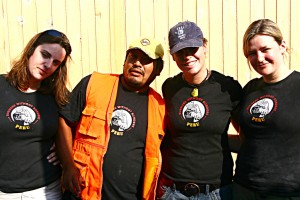
Civic Responsibility, –noun, According to Scribe’s book Tribes of Burning Man, Larry Harvey (also known as the Hat) resists attempts to define Burning Man as a countercultural movement. Rather, he sees the festival as a generator of culture in its own right. Practicing the principle of Civic Responsibility is one of the ways in which our culture sets itself as parallel to the default world rather than in opposition to it.
Participants take great pride in contributing to their temporary community. Even the smallest theme camps try to offer something to others or volunteer in some way to better their events. Unlike many underground festivals or raves, Burns obtain all necessary permits and work to form good relationships with local law enforcement and the communities where they take place.
Civic Responsibility does not end at the edge of the playa. When Hurricane Katrina devastated New Orleans during Burning Man in 2005, a team of experienced Burners took their equipment and skills to the area to assist with recovery efforts. This led directly to Burners Without Borders, which leverages Burners’ ability to thrive in extreme environments as way to aid disaster relief. This effort is just one of many — Burners all over the world work together to beautify, improve, and generally make reality camp more creative, pleasurable and fun.
In 2008, Austin area Burners effectively took over the city’s First Night celebrations, filling the streets with art and performance, and culminating in the burning of a gigantic clock tower. With over a hundred thousand in attendance, this became the largest ever Burning Man-style effigy ritual, and a great example of civic responsibility.
The Lexicographer has been soliciting the opinion of other thoughtful Burners on the Ten Principles. Below you will find another opinion, but more are still welcomed. Use the contact information at the top to send your thoughts.
Other entries in A Burner Lexicon can be found at https://kitoconnell.com/lexicon/

Participation has been important to Truffle since he attended his first Burn with the goal of placing a memorial at the Temple. Now he is a member of the Department of Public Works and spends 7 to 10 weeks a year on the playa. He had this to say on civic responsibility:
I gotta say, the radical sense of civic responsibility is my favorite. Usually this is viewed exclusively as: “Well, the organization uses some of my ticket money to help the locals, so I feel good about it.” But it’s a lot deeper than that: we’re playing at society here.
In reality, civic responsibility comes unexpectedly. For example, I’ve seen strangers chase down a rapist on the playa and keep sight of him until a Black Rock Ranger, and then an LEO could be found to handle the guy. I’ve seen strangers fill in on shifts they had no reason work, simply because the person they were relieving was overworked and in desperate need of sleep.
And yes: the organization does throw a lot of energy into civic responsibility. The first year I worked as DPW, the first week after the event the crew I was on drove along every road leaving the playa for nearly a hundred miles out, picking up trash that had blown off the sides of vehicles and was strewn all over the highway and desertscapes. Leave No Trace doesn’t end at the playa’s shoreline, ya know? We take responsibility for irresponsible participants even beyond the edges of our fair city.
It’s just that this is my favorite principle to see manifest in new burners, since usually they are completely taken by surprise that they have found meaning and purpose beyond themselves for their actions.